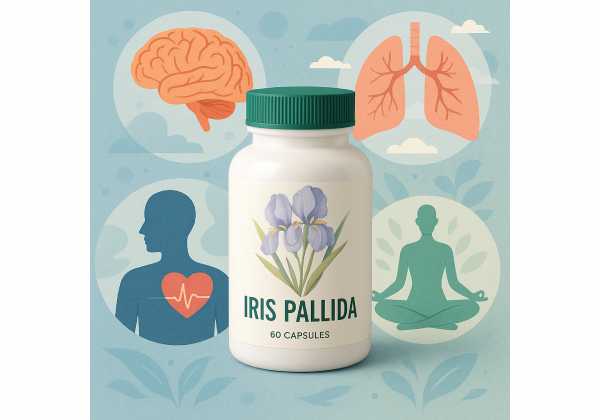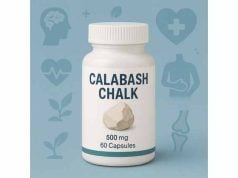
Iris pallida—often called the Dalmatian iris or, when cured, “orris root”—sits at a unique intersection of perfumery, traditional herb use, and modern cosmetic science. The rhizome, harvested and slowly cured for months to years, develops violet-like aromatic molecules (irones) while retaining phenolic and isoflavonoid compounds studied for antioxidant and anti-inflammatory activity. Today, most credible applications revolve around topical skincare and perfumery, with early lab data suggesting antimicrobial and collagen-supportive effects. Internal use, once mentioned in historical texts, is limited by a narrow safety margin and a lack of robust clinical trials. This guide separates fragrance myth from measurable mechanisms, clarifies how to evaluate products, and sets practical guardrails for safe, realistic use—especially for people curious about skin comfort, texture, and resilience under stress.
Essential Insights
- Most practical benefits are topical: cosmetic formulas with Iris pallida extract can support skin comfort and stress resilience.
- Internal use is not established and may irritate the gut; avoid self-dosing with raw or DIY preparations.
- Common cosmetic inclusion targets are roughly 0.1–1% extract equivalents; no evidence-based oral dose is established.
- Avoid if pregnant, breastfeeding, under 18, or if you have gallbladder disease, active GI conditions, or known sensitivity to irises.
Table of Contents
- What is Iris pallida and why do people use it?
- What benefits are realistic and how do they work?
- How to use it right: forms, preparations, and sensible “dosage”
- Customizing your approach: goals, skin types, and example routines
- Common mistakes and how to fix them
- Side effects, interactions, and who should avoid Iris pallida
- Research snapshot: what the evidence supports (and what it does not)
What is Iris pallida and why do people use it?
Iris pallida is a perennial bearded iris native to the Adriatic region and widely cultivated for its fragrant rhizome. After harvest, the rhizome is cleaned, sliced, and cured—often for 2–3 years—so that odorless precursors transform into irones, the violet-like molecules treasured in perfumery. This slow maturation creates the raw material commonly called “orris,” the backbone of many powdery floral accords. Beyond fragrance, the rhizome and leaves contain isoflavonoids (such as irigenin), phenolic acids, and other secondary metabolites under investigation for antioxidant, anti-inflammatory, and antimicrobial properties.
The marketplace uses “iris” loosely. Three labels show up most:
- Orris (Iris pallida, sometimes Iris germanica): Primarily a perfumery and cosmetic ingredient; modern interest focuses on skin comfort and texture.
- Blue flag (Iris versicolor): A different North American species historically used in tiny, bitter doses for digestive complaints; fresh rhizome is an emetic and irritant.
- Generic “iris root”: An imprecise term that may refer to any iris rhizome. Without a Latin binomial, it is impossible to evaluate safety or expected activity.
For consumers, species clarity matters. Iris pallida products are usually fragrance or cosmetic actives designed for external use. If you see capsules or tinctures labeled “iris root” without species and standardization, approach with caution. Internal use of raw or misidentified iris materials can cause nausea, vomiting, or contact irritation of the mouth and throat. Modern, people-first practice places Iris pallida squarely in topical applications where dose and pH are controlled and the risk–benefit profile is more favorable.
In short: Iris pallida earns its place in fragrance and skincare due to distinctive irones and a portfolio of phenolic compounds. The strongest real-world use today is topical, not oral. Respect the plant’s irritant potential and select well-formulated products that name the species and part used.
What benefits are realistic and how do they work?
People typically ask about Iris pallida for three reasons: cosmetic skin support, general antioxidant potential, and claims around microbial balance. Each area has a different certainty level.
1) Skin comfort and resilience under stress (most plausible today)
Modern in-vitro studies using human skin cells report that Iris pallida extract can blunt cortisol-driven changes associated with stress aging. In these models, treated cells maintained higher levels of type I procollagen and hyaluronic acid and showed reduced glucocorticoid receptor translocation. The practical translation: a rationale for positioning Iris pallida as a skin-comfort and texture-support ingredient, especially in leave-on serums and creams. Expect this benefit to be subtle and dependent on a balanced formula that also includes humectants, barrier lipids, and photoprotection. Real faces differ from cell cultures, so your lived result will hinge on concentration, product design, and routine.
2) Antioxidant and anti-inflammatory signaling (supportive evidence, cosmetic relevance)
Across the Iris genus, reviews catalog phenolics, isoflavonoids, and xanthones with free-radical scavenging and enzyme-modulating activity in vitro. For skincare, antioxidant capacity is relevant because it supports resilience against environmental stressors and helps preserve the extracellular matrix. As with most plant antioxidants, the best results come from consistent, moderate use rather than large, infrequent doses.
3) Antimicrobial and antibiofilm activity (promising, but not a drug)
Laboratory work on several Iris species, including Iris pallida, shows inhibition of early biofilm formation and quorum sensing in mixed oral bacterial models. That is interesting for oral-care adjuvants and hints at microbiome-friendly cosmetic roles. It does not turn Iris pallida into an antibiotic or acne cure. In practice, any antimicrobial contribution in a cosmetic sits alongside cleansing, pH control, and other supportive actives.
4) Fragrance and sensory pleasure (a real, quality-of-life benefit)
The orris profile—powdery, violet-like, slightly woody—can make daily routines more enjoyable. Sensory pleasure is an overlooked wellness dimension: if a product smells pleasant (without causing sensitivity), you are more likely to use it consistently, which enhances the chance of seeing benefits from the whole formula.
Manage expectations
- Iris pallida looks most useful as a supporting cosmetic active that complements barrier-focused basics.
- Benefits are incremental, not transformative; they depend on routine, concentration, and compatibility with your skin type.
- Systemic health claims (detox, thyroid support, weight loss) are not supported and distract from realistic, topical outcomes.
How to use it right: forms, preparations, and sensible “dosage”
With Iris pallida, formulation and route matter as much as the ingredient itself. The safest, most practical uses are topical and professionally formulated.
Topical formats you will see
- Serums and creams: Often list “Iris pallida root extract,” “Iris pallida leaf cell extract,” or “Iris pallida root powder.” Inclusion targets in modern formulas typically fall around 0.1–1% extract equivalents. Serums deliver concentration; creams add barrier lipids to reduce irritation risk.
- Toners and essences: Lower viscosity, lighter feel, useful for layering; concentrations trend lower than serums.
- Masks and cleansers: Short-contact formats can reduce irritation risk while delivering sensorial benefits.
- Fragrance-focused products: Orris resinoid or butter provides scent and may contribute minor emolliency; treat these as perfume rather than treatment steps.
Starting protocol for adults (topical)
- Patch test: Apply a small amount inside the forearm for 24 hours. If redness, stinging, or itch occurs, do not proceed.
- Begin once daily: Use after cleansing and before moisturizer or sunscreen. If also using retinoids or acids, alternate nights for the first two weeks.
- Evaluate at 4 weeks: Look for changes in comfort (less reactivity), texture (softness, hydration), and makeup laydown. If well tolerated but no clear benefit, adjust frequency or swap to a formula with complementary actives (niacinamide, panthenol, ceramides).
- Long-term pairing: Daytime with a broad-spectrum sunscreen; nighttime with a barrier-supportive moisturizer.
Internal use (not routine; clinician-guided only)
- There is no established oral dosing standard for Iris pallida with a favorable benefit–risk profile. Historical internal uses generally involve other species (e.g., Iris versicolor) and come with GI irritation risks, especially from fresh rhizome.
- If a qualified clinician proposes an iris-containing formula, expect very small, diluted “drop doses” or low-milligram capsule amounts for short trials, with clear stop rules at the first hint of nausea or abdominal discomfort. Most readers are better served by avoiding internal iris and choosing better-studied alternatives for digestive goals.
Home preparations
- Avoid DIY tinctures or decoctions from fresh or misidentified rhizomes. The sap is irritant, misidentification is common, and curing chemistry is nontrivial.
- If you cultivate irises, remember that curing orris to develop irones takes months to years and is a fragrance craft, not a shortcut to safe medicinal use.
Storage and handling
- Keep iris-containing products cool, dry, and capped.
- Wear gloves when handling raw rhizomes or garden sap to reduce dermatitis risk.
- Store away from children and pets; garden irises can be toxic if chewed.
Quick-reference ranges
- Topical cosmetic inclusion: about 0.1–1% extract equivalents.
- Oral dosage: Not established for consumer self-use; internal use is not recommended without professional oversight.
Customizing your approach: goals, skin types, and example routines
Iris pallida works best when slotted into a routine that matches your skin type and goals. Think of it as a supporting actor that shines when the basics are in place.
If your goal is daily skin comfort (normal to dry skin)
- Morning: Gentle cleanser → Iris pallida serum (thin layer) → moisturizer with ceramides → sunscreen.
- Evening: Creamy cleanser → Iris pallida cream or serum → richer moisturizer.
- Notes: If tightness persists, add humectants (glycerin) or occlusives (shea, squalane). Iris pallida is there to help temper stress signals; barrier nutrition does the heavy lifting.
If your goal is texture and fine-line support (photo-exposed, combination skin)
- Morning: Water-based cleanse → Iris pallida serum → lightweight moisturizer → sunscreen.
- Evening: Retinoid on alternate nights; on nights off, apply Iris pallida serum then a peptide or panthenol cream.
- Notes: Iris pallida may complement retinoids by improving comfort on off nights. Introduce slowly to avoid cumulative irritation.
If your goal is resilience under stress (urban exposure, frequent travel)
- Morning: Antioxidant toner → Iris pallida essence or serum → moisturizer → high-SPF sunscreen.
- Evening: Double cleanse → Iris pallida cream → sleeping mask two or three times weekly.
- Notes: Keep a small travel set; consistency beats intensity. Hydration and UV protection remain the top levers.
If you have reactive or sensitive skin
- Choose formulas marketed as fragrance-reduced or essential-oil-free to avoid unrelated sensitizers.
- Start at every-other-day application for two weeks. If redness or stinging appears, stop and reassess; another soothing active (madecassoside, colloidal oatmeal) may suit you better.
If you are acne-prone
- Iris pallida is not a primary acne treatment. Use established actives (benzoyl peroxide, adapalene, azelaic acid) and select an iris product for comfort on non-treatment nights.
- Prefer lightweight, non-comedogenic vehicles (gel-serums). Patch test, because plant extracts can still provoke irritation.
Oral-care exploration (theoretical, product-dependent)
- Some formulators test Iris species in mouthwashes for antibiofilm support. If you try such a product, ensure it is commercially formulated, alcohol-sensible, and labeled for oral rinse use—not a DIY extract.
Example 7-day on-ramp (face routine)
- Days 1–2: Apply once nightly after cleansing.
- Days 3–4: Add mornings if no irritation.
- Days 5–7: Maintain twice-daily or revert to nightly based on comfort.
- At any sign of tingling that persists, erythema, or tightness, step back to once daily or pause for 72 hours.
When Iris pallida is not the best match
- If your primary aim is post-meal fullness or bile support, look to artichoke leaf extract or gentian bitters with better human data.
- For barrier repair, prioritize niacinamide, ceramides, and cholesterol.
- For photoaging, retinoids and broad-spectrum sunscreen remain the highest-yield steps.
Common mistakes and how to fix them
Mistake 1: Mixing up species
Seeing “iris root” and assuming all irises behave the same leads to confusion. Orris (usually Iris pallida) is primarily a fragrance and cosmetic material; blue flag (Iris versicolor) is a different herb with a narrower safety margin. Fix: Check the Latin name, plant part, and intended route on the label.
Mistake 2: DIY internal dosing
Chewing or steeping fresh iris rhizome is a fast path to nausea and vomiting. Fix: Avoid internal iris unless a qualified clinician prescribes a specific, low-dose protocol—and even then, consider safer alternatives first.
Mistake 3: Skipping the patch test
Irises can cause irritant or allergic contact dermatitis, especially in those handling plants regularly. Fix: Patch test every new product for 24 hours on the inner forearm.
Mistake 4: Chasing concentration over formulation
More extract is not automatically better; comfort depends on the whole formula—pH, humectants, emollients, and preservative system. Fix: If irritation occurs, reduce frequency, switch vehicle (serum → cream), or choose a formula with barrier co-actives.
Mistake 5: Treating iris as a cure-all
Iris pallida is a supporting ingredient. Expect modest improvements in comfort and texture, not a replacement for sunscreen, retinoids, or prescription care when needed. Fix: Keep foundational steps in place and use iris as an adjunct.
Mistake 6: Buying vague or unlabeled products
“Herbal iris drops” or “iris root capsules” without species, part, standardization, or testing are red flags. Fix: Choose brands that specify Iris pallida, list rhizome or leaf clearly, and provide third-party testing for identity and contaminants.
Mistake 7: Ignoring special conditions
Pregnancy, breastfeeding, gallbladder disease, active GI disorders, and childhood are no-go zones for internal iris. Fix: Stick to topical use or pick better-studied options for your goal.
Mistake 8: Overlapping too many actives
Stacking acids, retinoids, and astringent botanicals invites irritation. Fix: Layer thoughtfully; alternate nights; listen to your skin.
Side effects, interactions, and who should avoid Iris pallida
Adverse effects to watch for
- Skin irritation: Redness, stinging, or dermatitis—more likely with higher fragrance content or in sensitive skin.
- Mucosal irritation: Burning of the mouth or throat can occur if raw plant material or concentrated extracts contact mucosa.
- Gastrointestinal upset (oral use): Nausea, vomiting, cramping, and diarrhea have been reported with iris species, particularly when fresh rhizome is ingested.
Who should avoid internal use (and use topical with caution)
- Pregnant or breastfeeding individuals.
- Children and adolescents under 18.
- People with gallstones, biliary obstruction, active peptic ulcer, or inflammatory bowel disease.
- Anyone with known sensitivity to irises or fragrance components (e.g., irones).
- Those with severe liver or kidney disease—do not self-medicate with botanicals that may irritate mucosa or alter bile flow.
Potential interactions
- GI-irritating drugs (e.g., NSAIDs): Additive stomach upset if iris is taken internally.
- Agents affecting bile flow: Theoretical additive effects; avoid iris internally in gallbladder disease.
- Antiemetics or antidiarrheals: If you need these after taking iris, stop the iris rather than layering more medicines.
Accidental exposure and overdose
- Topical: Rinse with cool water if burning occurs; discontinue the product.
- Oral ingestion: If significant fresh or concentrated material is swallowed and symptoms (vomiting, severe abdominal pain, diarrhea) develop, seek urgent medical care. Bring the product label or plant sample if safe.
Safe-use checklist
- Prefer topical, cosmetic-grade products; avoid raw or DIY extracts.
- Patch test every new product for 24 hours.
- Introduce slowly; alternate nights with strong actives.
- Store securely, away from children and pets.
- Set clear stop rules at the first sign of intolerance.
Bottom line: Iris pallida has a narrower safety margin than many mainstream botanicals when taken internally. Most readers should keep use topical and conservative, reserving internal experimentation for clinician-supervised scenarios—if at all.
Research snapshot: what the evidence supports (and what it does not)
What is well described
- Genus-level chemistry and pharmacology: Recent reviews compile robust data on Iris species chemistry (phenolics, isoflavonoids, xanthones) and report antioxidant, anti-inflammatory, hepatoprotective, and antimicrobial activities in vitro and in animal models. Iris pallida appears frequently in these summaries due to its economic relevance and distinctive irones.
- Cosmetic-relevant mechanisms: In human skin cell models, Iris pallida extract attenuates cortisol-induced declines in type I collagen and hyaluronic acid while interfering with glucocorticoid receptor translocation—consistent with claims around skin comfort and texture under stress.
- Antibiofilm activity: Extracts from several Iris species—including Iris pallida—disrupt early biofilm formation in mixed oral bacterial models and influence quorum sensing. That is a mechanistic foundation for oral-care or cosmetic hygiene claims, not proof of clinical efficacy.
What remains uncertain
- Human clinical trials for defined endpoints: There are few controlled human studies testing Iris pallida for dermatologic, digestive, or systemic outcomes. Most supportive data are preclinical or cosmetic usage reports.
- Standardization targets and dose–response: Unlike botanicals with well-defined actives (e.g., silymarin in milk thistle), Iris pallida lacks consensus on clinical marker compounds and dosing frameworks for internal use.
- Long-term dermatologic safety: Case reports document allergic contact dermatitis to iris components, especially in fragranced cosmetics. Incidence in modern, low-irritant formulas remains to be better quantified.
Clinical and consumer takeaways
- Treat Iris pallida as an adjunct in skincare with plausible mechanisms but modest, formulation-dependent visible benefits.
- For internal goals (digestion, bile flow), choose alternatives with stronger human data and wider safety margins.
- If you value sensory experience, orris-inflected formulas can make routines more enjoyable—an underrated adherence benefit.
Research horizon
- Newer reviews highlight novel niches—exosome-like vesicles with potential skin benefits and extract-coated nanoparticles for environmental applications. These findings are scientifically interesting but not consumer-ready therapies. Future work should focus on controlled human trials, standardization, and dermatologic safety at real-world use levels.
References
- The Genus Iris Tourn. ex L.: Updates on Botany, Cultivation, Novel Niches and Impactful Applications 2025 (Systematic Review)
- Exploring the Use of Iris Species: Antioxidant Properties, Phytochemistry, Medicinal and Industrial Applications 2022 (Systematic Review)
- Iris pallida Extract Alleviates Cortisol-Induced Decrease in Type 1 Collagen and Hyaluronic Acid Syntheses in Human Skin Cells 2023 (In Vitro)
- Phytochemical Composition and In Vitro Biological Activity of Iris spp. (Iridaceae): A New Source of Bioactive Constituents for the Inhibition of Oral Bacterial Biofilms 2020 (In Vitro)
- Allergic contact dermatitis to Iris germanica root in a “natural” cosmetic 2021 (Case Report)
Medical Disclaimer
This article is informational and is not a substitute for professional medical advice, diagnosis, or treatment. Iris pallida and related iris species can irritate skin and mucosa, and internal use may cause gastrointestinal distress. Do not ingest iris products if you are pregnant, breastfeeding, under 18, or have gallbladder disease, active gastrointestinal conditions, or a known sensitivity to irises. Seek urgent care for severe reactions such as persistent vomiting, significant abdominal pain, or swelling with breathing difficulty. If you take medications or manage chronic conditions, consult a qualified clinician before using any iris-containing product.
If you found this guide useful, please consider sharing it on Facebook, X (formerly Twitter), or any platform you prefer, and follow us for future evidence-aware articles. Your support helps us continue producing high-quality content.








